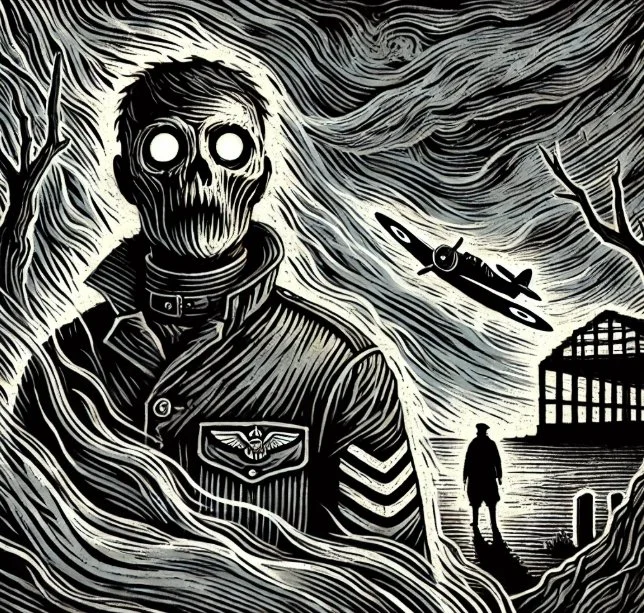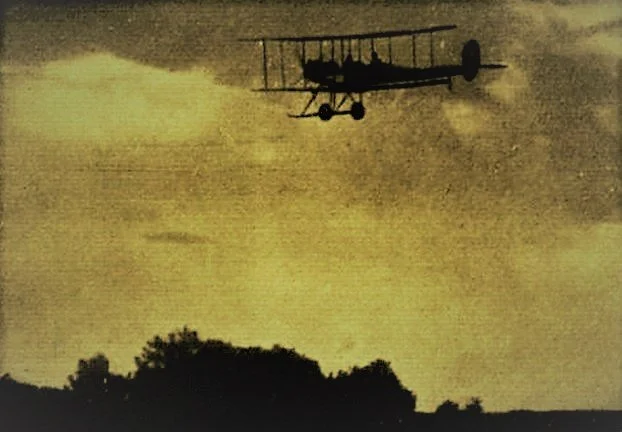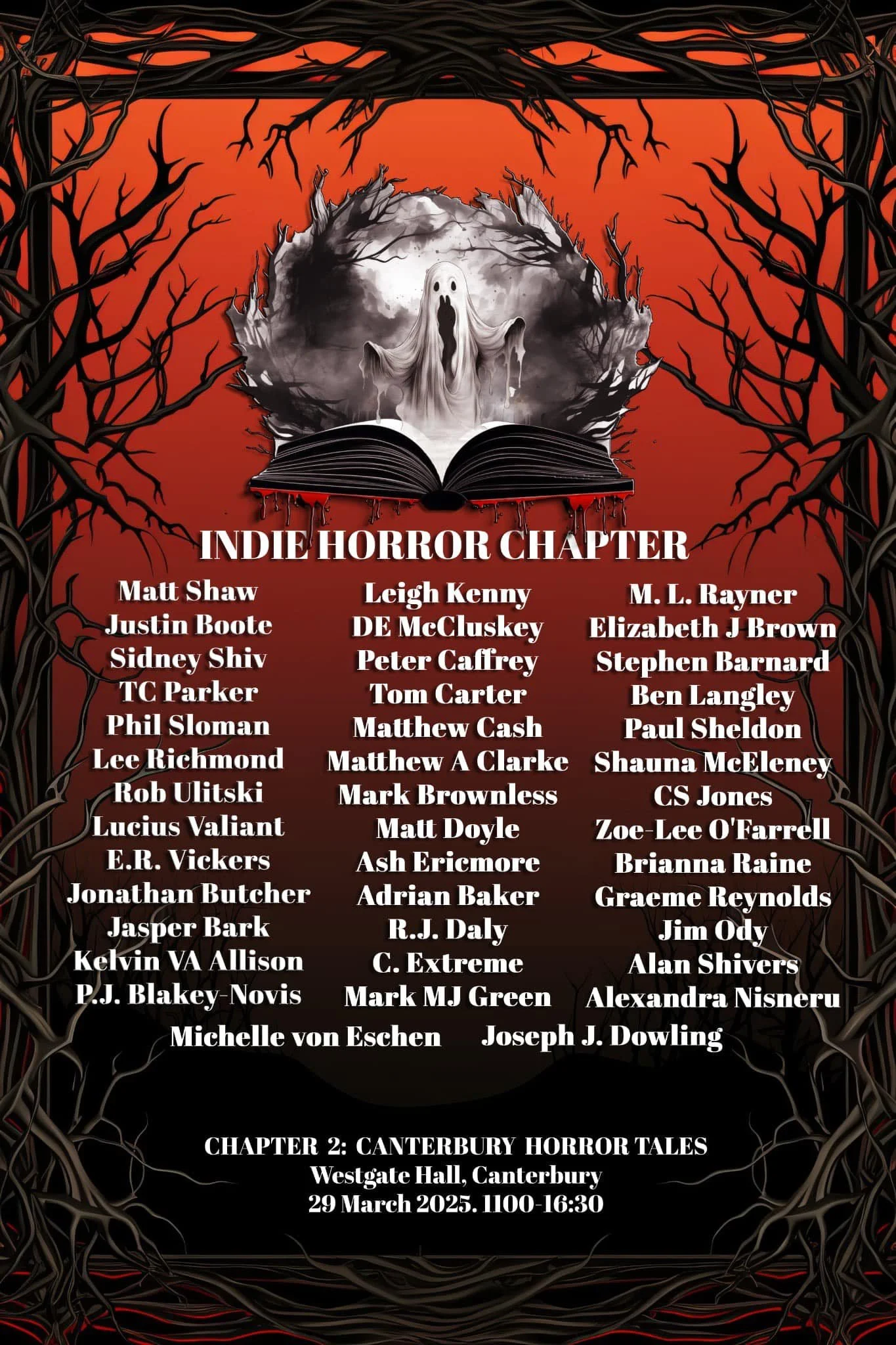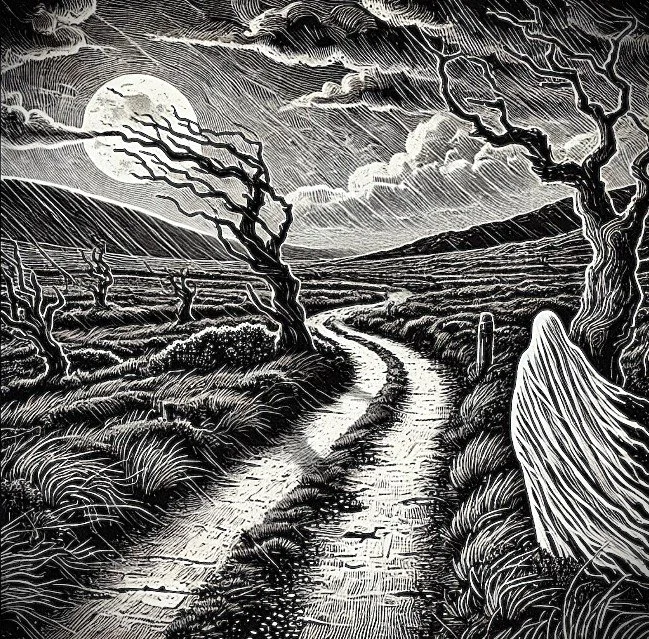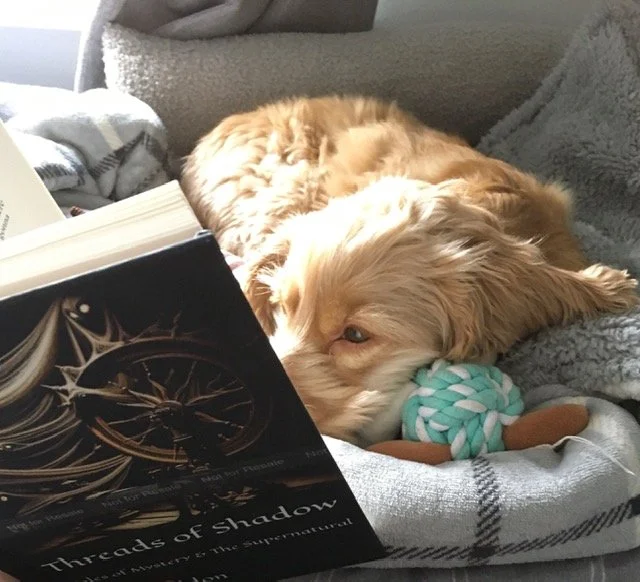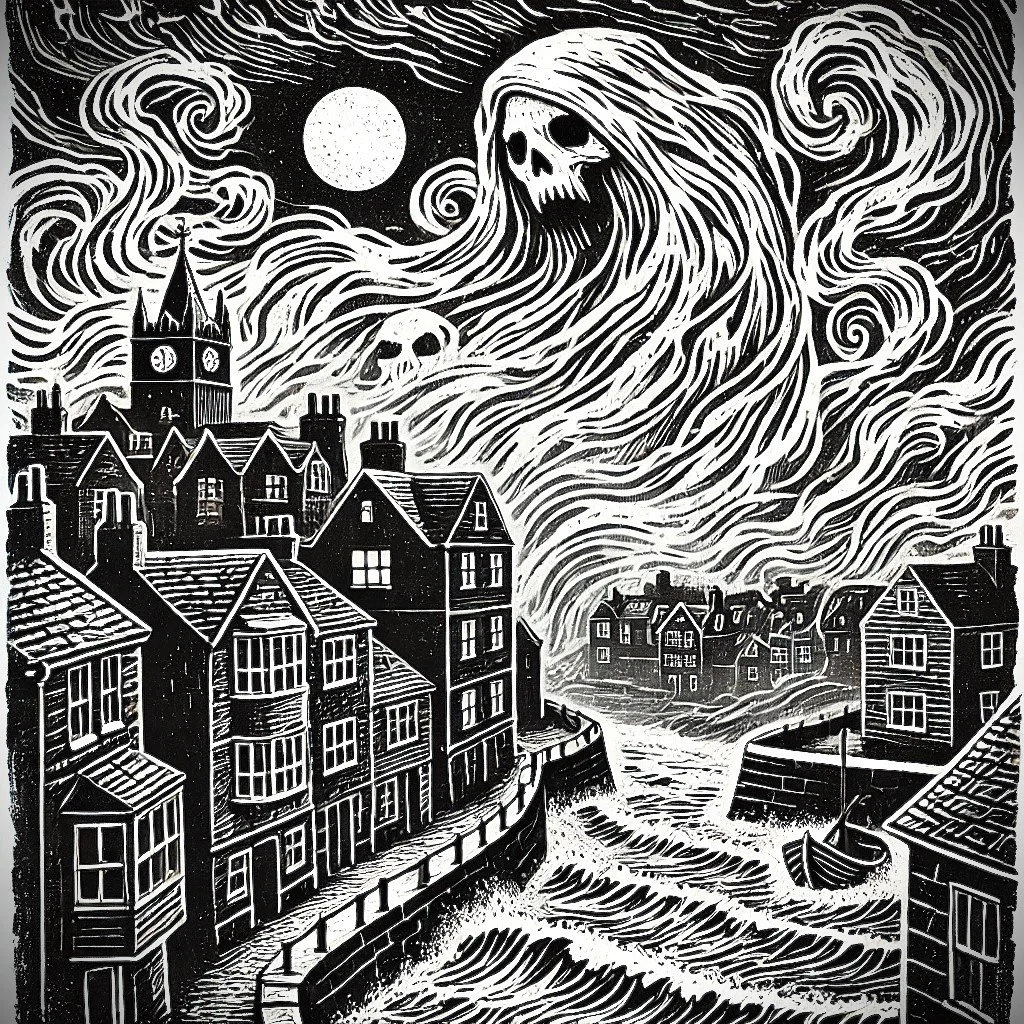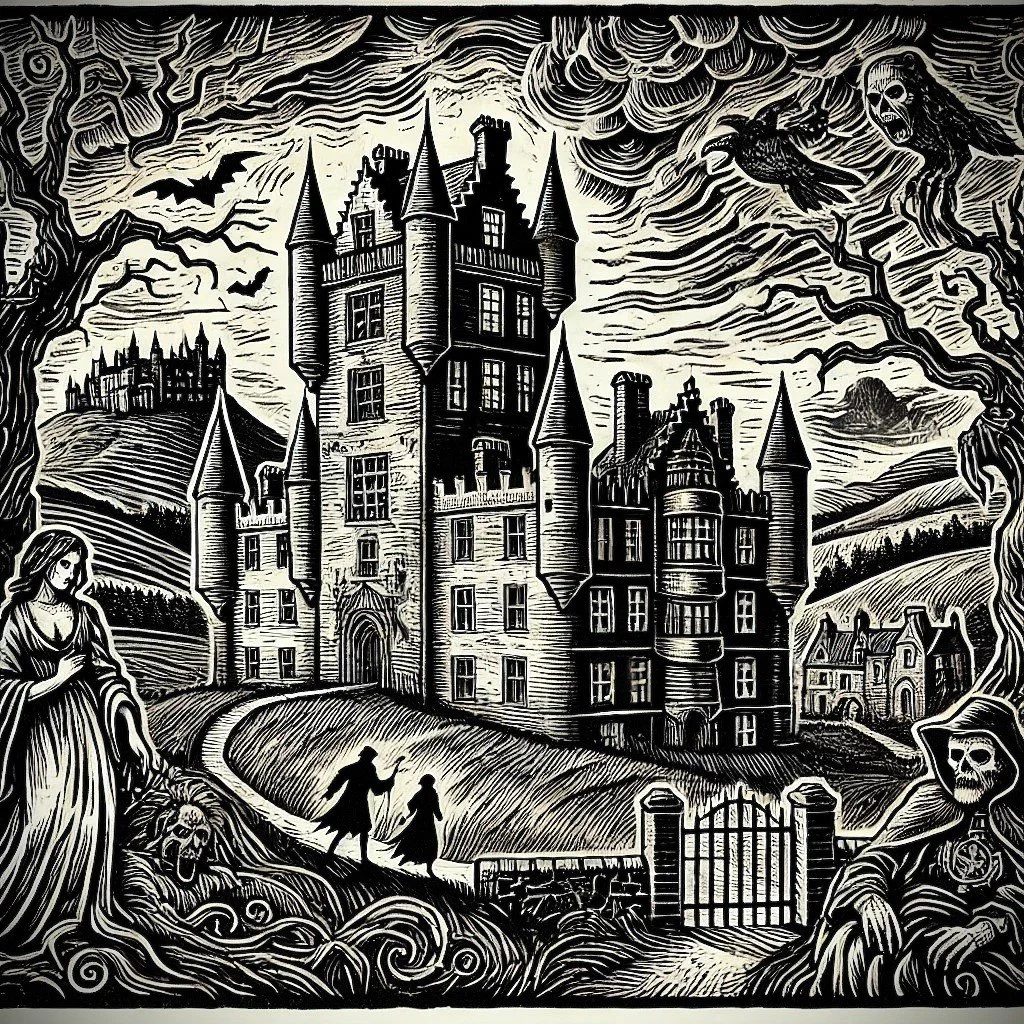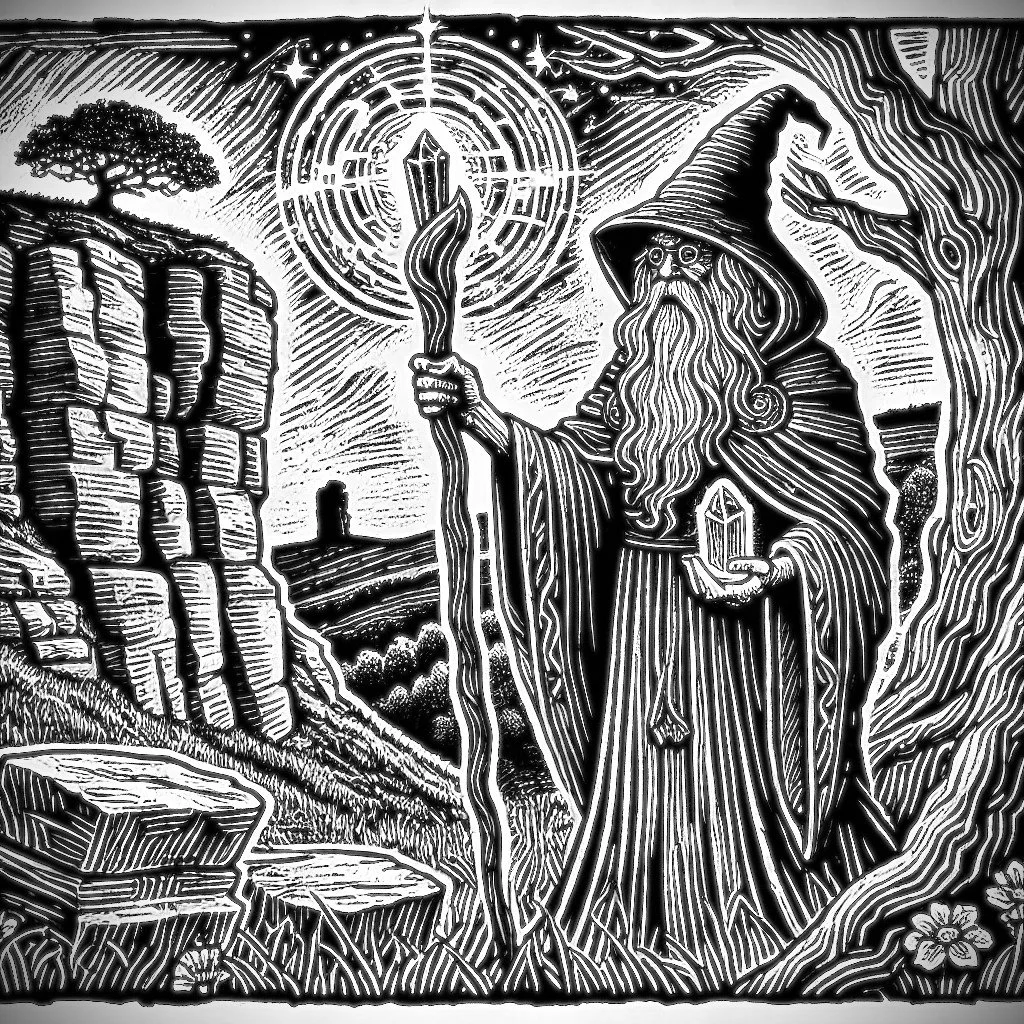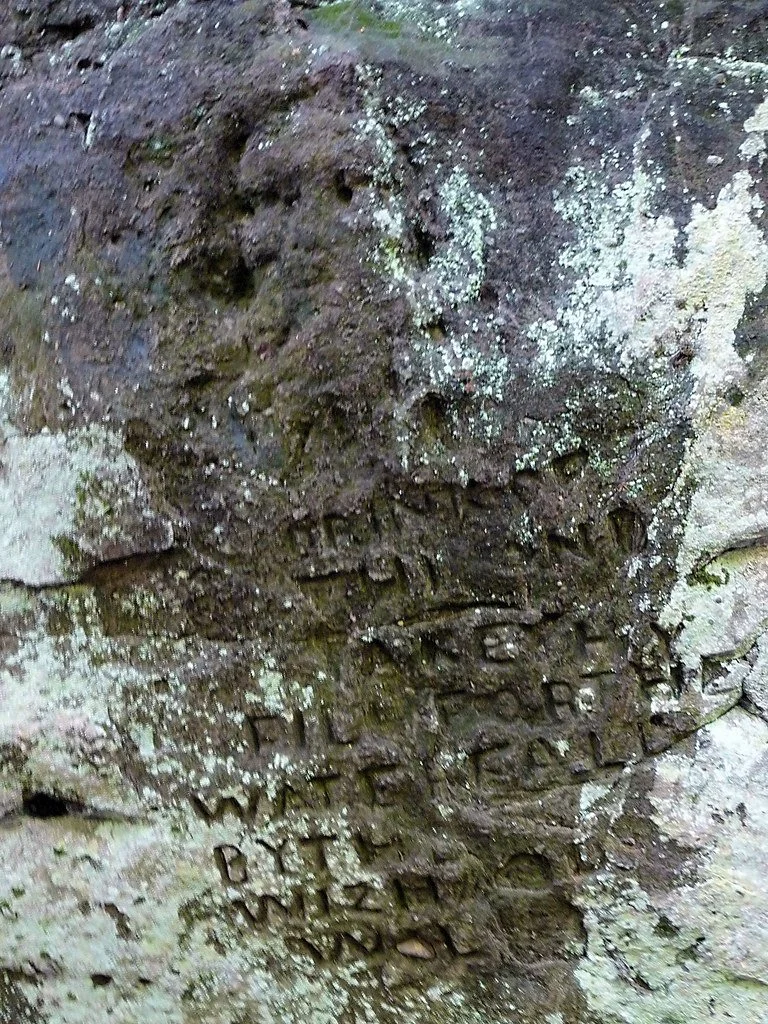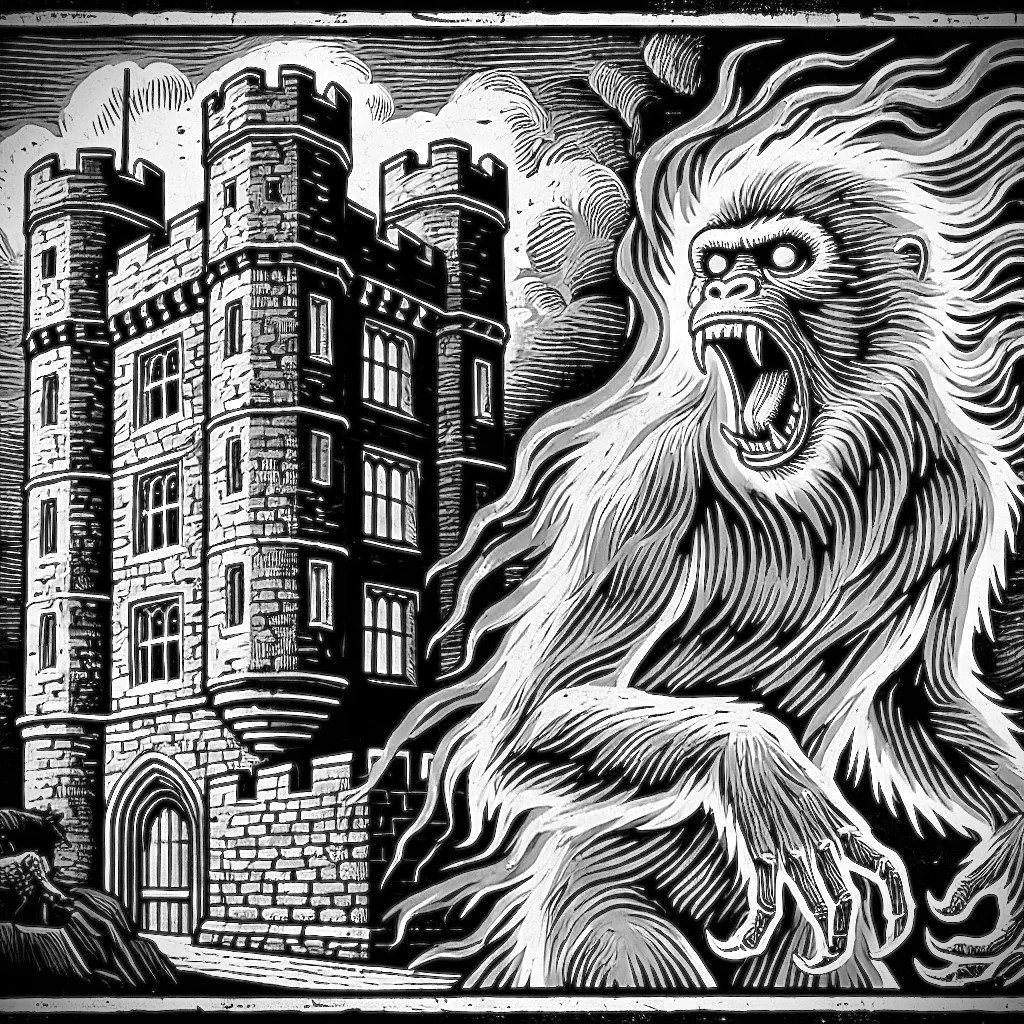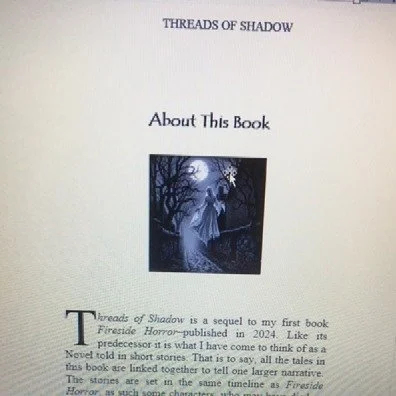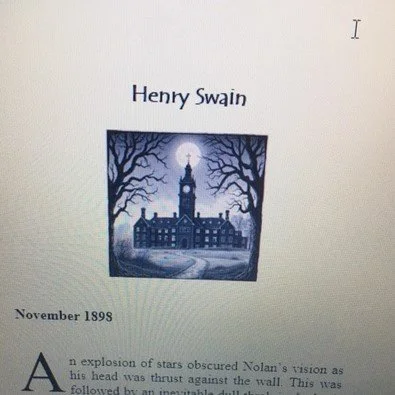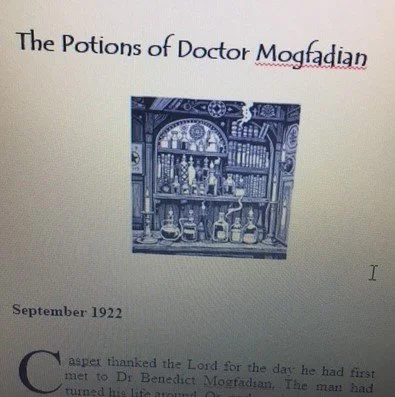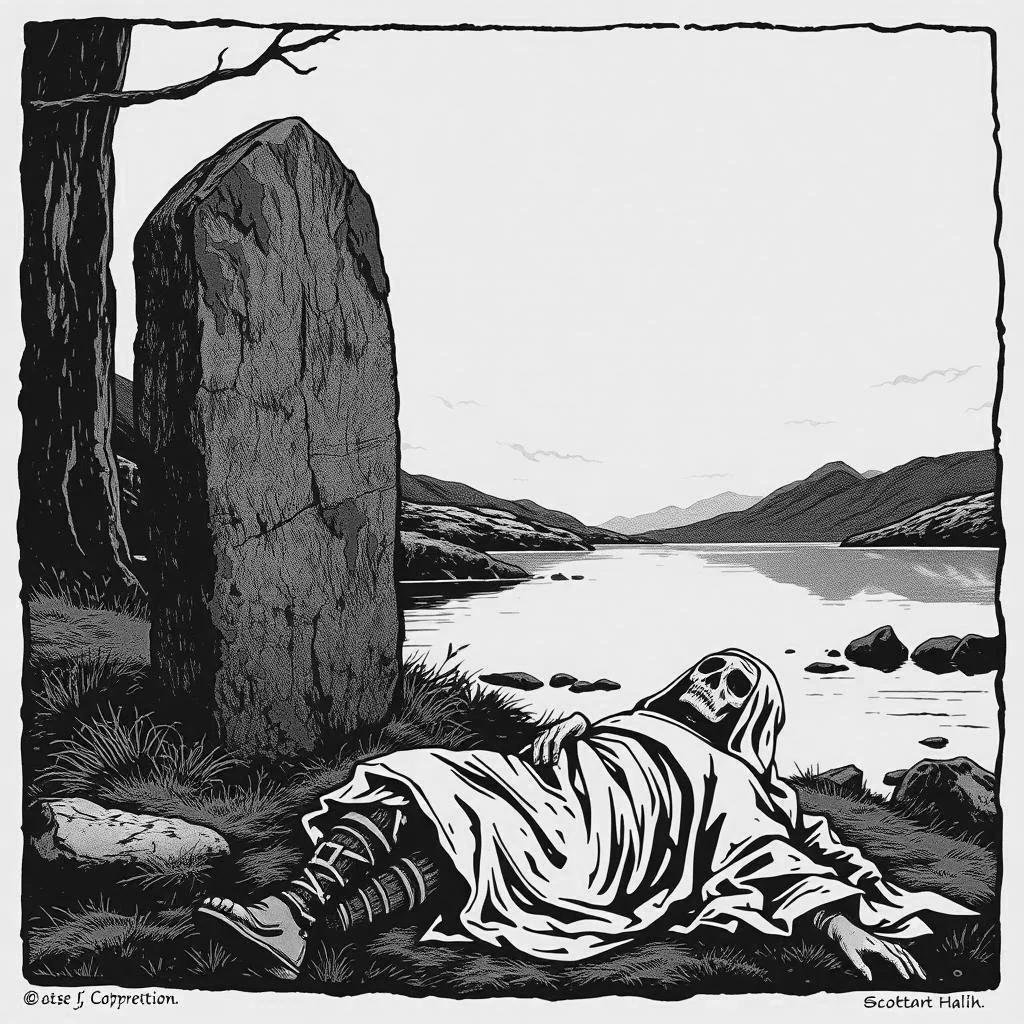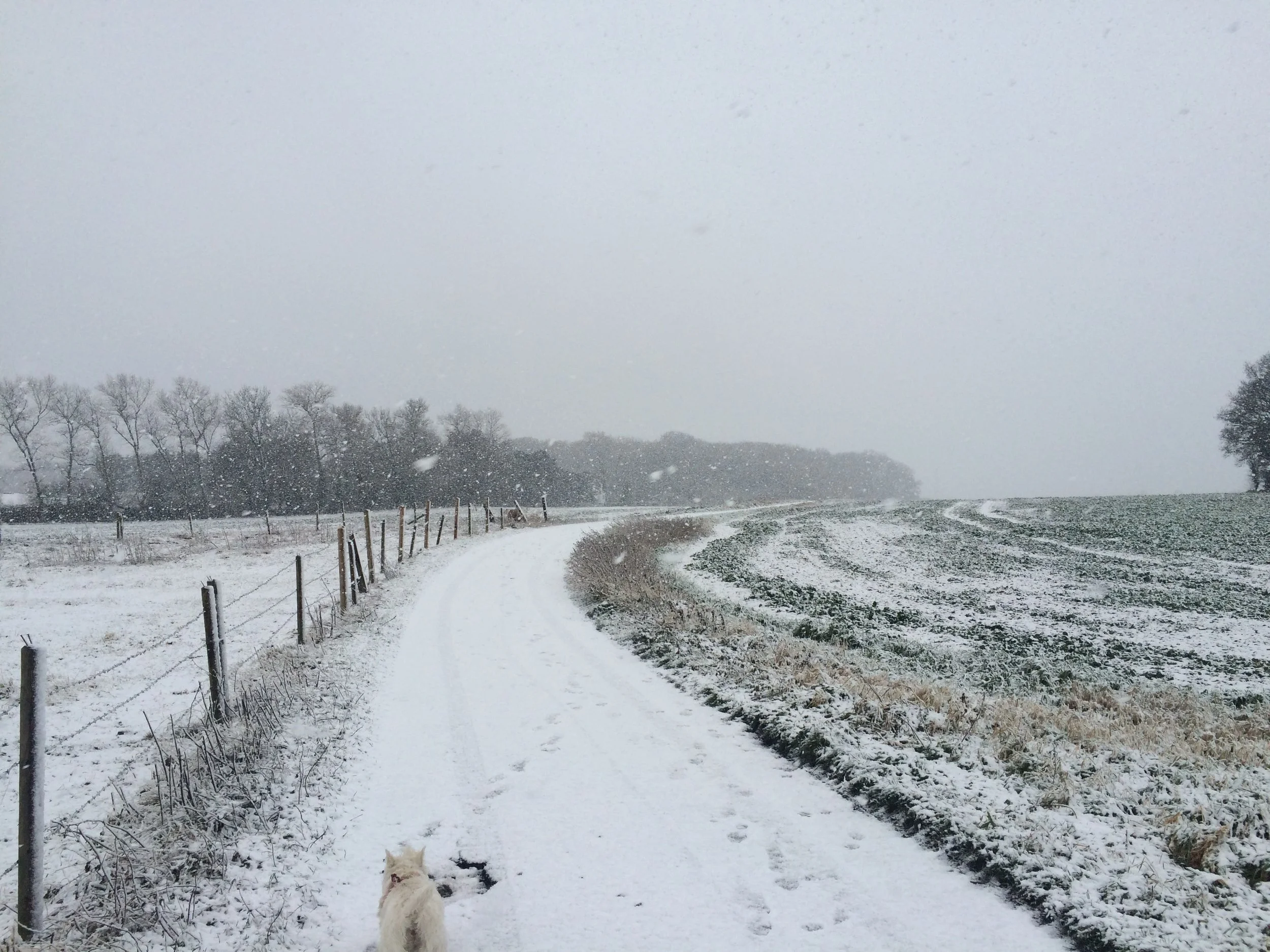Ghostly Folklore - The Phantom Train of Dunphail
The Grey Ghost Train - Beware…
The ghost train is an iconic kind of haunting - although I would suggest an uncommon one. The idea of a spectral steam engine, charging through the night, belching flames and smoke, terrifying onlookers, only to vanish before their very eyes, instils that pleasing terror that lovers of spooky folklore regularly quest for.
In Northern Scotland, in Moray (Scottish Gaelic: Moireibh or Moireabh.) There runs the Old Dava Railway line. This section of track was opened in 1863 and ran over the old Dava Moor, for a while this was the main route to London. Sadly the line did not survive Mr Beeching’s axe and was closed down in 1965. The Dava Way, is a modern Railway walk, managed by The Dava Way Association (DWA.) Thanks to this hardworking group, you can trek the route taken by those old time trains today. However, to take this journey at night might require a little liquid courage (Whiskey) beforehand.
The Legend of the Grey Train of Dunphail.
Dunphail Railway Station, near Forres, is the scene of a terrifying haunting, folklore suggests that a locomotive carrying cattle met a fiery end nearby, and that this has resulted in its ghostly apparition being spotted intermittently since the 1920s, with sightings even as recent as the 1960s.
Sightings
On a clear winter’s night, John Macdonald was heading home along a path close to Dunphail railway station, when a locomotive with a full head of steam, pulling four carriages, appeared and rushed past the startled local. MacDonald claims the train was travelling around 2ft above the tracks. The date of John’s sighting varies depending on the source, with claims it was sometime between 1917 and 1920.
Two men alleged to have witnessed a strange bright light on the track whilst in a railway cutting. Eventually it faded away. One of the men reported it to the Stationmaster the next day, and discovered that many other people had encountered this unexplained illumination.
One evening in 1949, a woman was returning home after visiting a relative, she was walking along the track, secure in the knowledge that no trains ran at that time of night. To her surprise she claimed to hear a steam engine coming up the line. The noise grew louder and she looked over her shoulder, to her horror she saw the spectral grey train approaching her at full steam. In a panic the poor woman scrambled up the bank and fell to the ground whilst the phantom locomotive raced through the night below her, she reported seeing the fierce glow of the firebox reflected in the pall of smoke from the chimney, and brightly lit carriages streaming behind, all of which were some two feet off the ground!
If you would like more information on the old railway line and its history I enclose a link to the Dava Way website below, it is well worth a visit.
Thank you for taking the time to read this blog my friend. If you enjoy stories of ghosts, monsters, and the uncanny, please consider supporting me by purchasing a copy of my book ‘Fireside Horror,’ a novel told in short stories, each one certain to send a shiver down your spine. Available on Amazon and Audible, Link Below.
Until next time, stay spooky.
Ghostly Folklore – The Haunting of RAF Montrose
Scary goings on at the now abandoned Airbase.
RAF Montrose (also known as Royal Airforce Base Montrose.) Was one of the country’s most haunted military airfield bases; located in Angus, Scotland, it was the first operational military airbase in Britain, being set up on 26th February 1913, and was one of twelve air force bases planned at the time for the United Kingdom, its was intended to allow the then Royal Flying Corp to provide protection to nearby naval bases.
There are a great many ghosts to be found at this now unused airbase (it closed permanently on 4th June 1952.) From reports of damaged radios, playing old wartime broadcasts, as well as phantom planes being seen overhead, only to mysteriously vanish before the viewer’s eyes, to spectral pilots, wandering about the base at night. Indeed such was its reputation that newcomers to the airbase were given a printed document to help familiarise themselves with the site, a part of which warned about the expected paranormal sightings.
The most famous of Montrose’s phantom inhabitants, and possibly one of the first aviation hauntings, is that of Irishman Desmond Arthur (Picture above), who fell to his death on May 27, 1913, when his plane broke up. His story is recounted below.
On 23rd of May, 1913, at around 7.00am in the morning Arthur took his BE2 biplane for a training flight, after flying for about forty minutes, The right wing broke off the aircraft and Arthur’s seatbelt failed, throwing him out of the plane as it went into a death spin.
One report at the time claimed that the luckless pilot had jumped from the plane of his own free willing, instead of choosing to crash with the machine. The accident was witnessed by an individual on a nearby farm, who provided the authorities with the following macabre details. He heard the plane overhead, and then a strange sound. Looking skywards he saw something plummeting to the ground. Horrified he realised that it was a man, falling in perfect silence. The body of the doomed aviator, was perfectly straight, with its arms held directly above its head. When medics arrived at the scene, Arthur was found dead, nearly every bone in the poor man’s body had been broken.
An Enquiry held after the event blamed the incident on poor manufacturing.
There have been many sightings of Arthur’s ghost over the years, he has been seen walking to the mess hall, vanishing before he reaches its entrance. One pilot spoke of awaking in the middle of the night and feeling terribly cold, looking around he saw a uniformed man sitting in a chair. When he tried to speak to him, the individual slowly faded away.
Thank you for taking the time to read this blog my friend. If you enjoy stories of ghosts, monsters, and the uncanny, please consider supporting me by purchasing a copy of my book ‘Fireside Horror,’ a novel told in short stories, each one certain to send a shiver down your spine. Available on Amazon and Audible, Link Below.
Until next time, stay spooky.
Event Update – The UK Indie Horror Chapter 2: Canterbury Horror Tales
Attention all horror fans, the 29th March 2025, will see the 2nd Indie Horror Chapter Event, a collection of 40, yes that’s right 40 of the best Indie horror and dark literature authors all gathered together in one venue. The event organisers have wisely chosen to contain this terrifying horde (of which I am one) in: Westgate Hall, Canterbury, CT1 2BT. Thus protecting the general population of this historic town from untold nightmares. Entry is free, doors will be opened at 11.00am and will close at 4.30pm.
If you feel brave enough please come down and say hello to us all, I can say - with a fair degree of confidence - that none of us bite. There will be a book fair and readers can not only meet and chat with the authors, but can enjoy a host of other activities including readings, discussion panels, and more. The list of authors in attendance is given below. I have also enclosed a link to the Indie Horror Chapters Webpage
Ghostly Folklore- The Haunted Bog Road of Connemara
An old road through dangerous terrain.
In the North West of the County of Galway, in the Republic of Ireland, is to be found Connemara National Park (Irish: Páirc Naisiúnta Chonamara.) This is an area of savage beauty, containing, Mountains, Bogs, Woodland, and Heaths. The gruesome tale I am going to relate concerns this regions extensive Bog land.
The Old Bog Road, was originally the main route to Galway. Before the founding of Clifden (Irish: An Clochán, meaning 'stepping stones.') A coastal town, found where the Owenglin River flows into Clifden Bay. Today many local people refuse to travel the Bog Road at night, going out of their way to avoid the route.
One local from the picturesque village of Roundstone tells the following tale. “I was giving a lift to two old fellas who insisted that they would get out of the car if I turned down the Bog Road… Who am I to say?” Yet another man from Clifden claimed. “People say it’s haunted. Folks do drive off the road a good bit. I wouldn’t be driving it at night, and certainly not alone.”
The Legend of The Old Bog Road.
The story goes that there was an Inn on the old Bog Road named ‘The Halfway House.’ Many years back in the 1790s, it was run by a brother and sister. This ghoulish pair, made it their business to invite lonely travellers to rest the night at their hostelry, however their motives were not altruistic. They would wait until the luckless traveller had settled down for a restful night’s sleep, then on the stroke of midnight they would creep into the persons room, murder them, steal their belongings, and dispose of the body in the surrounding Bogs or Lakes.
It is the ghosts of these hapless victims – whose bodies the murderous siblings fed to the windswept Bog Land – that haunt this lonesome stretch of road, strange shadows can be seen crawling out of stagnant pools, dark shapes flit before cars, and lonely figures are spotted standing by the wayside, only to vanish should a traveller pull over to offer them a lift.
So dear reader, should you find yourself alone in Connemara, why not test your courage, wait until the sun has set in the westering sky, get behind the wheel of your vehicle, and drive along the benighted Bog Road, will you have the nerve to do it? What will your headlights reveal?
Until next time stay spooky my friend.
Update - Threads of Shadow.
Lily attempts to proof the read the text, but being illiterate, and a dog, she is of no help. She must be useful for something?
Hello my friends, just a short update on my next book ‘Threads of Shadow.’ I have finished writing and revising the text of what will be book two of ‘The Wendlelow Mysteries,’ and have just dispatched a copy to my editor Carson Buckingham. This part of the process usually takes a few weeks. When I receive it back I will start the process of editing the text, this could take up to a month, then I will have to dispatch the book to a few folks willing to give it an advanced read and help me hunt down any typos and further gremlins in the revised version, hopefully the book will be ready for general release in two to three months.
PLEASE NOTE ALL PROOF READING POSITIONS ARE NOW FILLED. A BIG THANK YOU TO EVERYBODY WHO APPLIED.
If you are interested in being apart of the advanced reader group. please message me, I will dispatch a free copy of the book. in either physical or Ebook format, which ever you prefer. I will acknowledge your contribution in the ‘Authors Note’ section of the book. Futhermore, as a thank you, I will send you a signed copy of the book when it is finally released. I’m looking for about three to five people. If you are interested, please message me via the contact section on this website, or through Facebook.
Stay Spooky.
Ghosts and Legends of St. Ives.
Spectral happenings in the little coastal town of St. Ives.
Deep in the English County of Cornwall, clinging to the storm tossed coastline is the historic seaside town of St. Ives. (Cornish: Porth Ia, meaning St Ia’s cove.) Once a prosperous fishing port, a recent decline in this trade has seen the towns economy shift more towards tourism.
St. Ives is home to The Sloop Inn, an old fisherman’s pub dating back to the 14th Century and believed to be Cornwall’s oldest pub. The seaside town has been home to Smugglers, Wreakers and is a favourite location for artists. So it has plenty of history and also a great deal of local legends and ghosts guaranteed to peak the interest of any budding myth hunter.
Saint Ia of Cornwall
St. Ives is associated in legend with the arrival of St. Ia in Cornwall. St. Ia was an Irish Princess from the 5th Century, who became a saint and martyr. She arrived at the sea shore to discover that her companions had departed for Cornwall without her. Upset she prayed, and noticing a small leaf floating on the sea, touched it with a rod to see if it would sink, but it grew larger. Trusting God, she embarked upon the leaf and was carried across the Irish Sea, arriving at Cornwall before the others.
Dead Man’s Walk
Dead Man’s Walk is a narrow, shadowy lane, that was once the route taken by condemned prisoners making their final journey to their place of execution. It is a area best avoided at night, as people walking there describe feelings of depression and terror. Shadowy figures and ghostly footsteps have also been reported here. It is said that if you are wandering down this street and hear the church bells ring an extra chime, it is a sign of a guilty conscience.
Trencrom Hillfort
Not far from St. Ives lies, Trencrom Hill fort, orginally called Torcrobm the name is derived from the Cornish "torr crobm", meaning, 'hunched bulge.' it was first used as a settlement in the neolithic period, and then used as a hillfort in the Iron age. Legends says that the treasure of a great Cornish giant is buried somewhere on Trencrom, supposedly guarded by Spriggans, a race of grotesquely ugly, wizened old men with large childlike heads.
The Lady with the Lamp
There is told - about the town - the sad tale of a ghostly woman who wanders about the beach bearing a spectral lamp. She is believed to be a mother whose baby was swept into the sea during a storm and was lost forever. The grieving woman passed away shortly after this tragic event, and though her body was laid to rest, her spirit was not. Locals say that even today a flickering light can be seen on the beach before a storm, and that this light is the Lady with the Lantern, wandering the lonely sands in search of her lost baby.
Thank you for taking the time to read this blog my friend. If you enjoy stories of ghosts, monsters, and the uncanny, please consider supporting me by purchasing a copy of my book ‘Fireside Horror,’ a novel told in short stories, each one certain to send a shiver down your spine. Available on Amazon and Audible, Link Below.
Until next time, stay spooky.
Ghostly Folklore - The Black Dog of Newgate Prison
The Black Dog - Terror of The Gaol.
The dreaded Newgate prison was located just inside the city of London. Originally built in the 12th Century during the reign of Henry II, it was part of an original roman gate built into the wall that surrounded old London town. Since it was first constructed it has been rebuilt and extended many times, and was in use until 1902.
Newgate had a poor reputation that dipped to its lowest level in the 15th Century, when the decaying building became a place of true misery, prisoners were dying from the overcrowding, rampant disease, and bad sanitary conditions. It is thought that a total of 22 prisoners died of ‘Gaol Fever’ (Also known as Typhus Fever.) As a result it was decided to renovate and improve the prison.
It was destroyed in the Great fire of London during 1666 and rebuilt again around six years later, with the addition of a windmill to the roof - an attempt to improve ventilation. In 1783 the site of the cities gallows were moved from Tyburn to Newgate, with hangings being performed in the street before the prison in front of jeering, unruly crowds. Until eventually the gallows were moved inside the prison walls.
The Black Dog
Held within the Guildhall Libraries aged stacks, is an old work with the wonderful title. ‘The Discovery of a London Monster, called The Blacke Dogg of Newgate: Profitable for all Readers to Take Heed by.’ Supposedly a true account written by a prisoner called Luke Hutton.
During a period of famine in the reign of King Henry III, desperation drove the prisoners to new depths of savagery. Among them languished a scholar, whispered to be a sorcerer, a manipulator of the dark arts, and diabolical witchcraft. This ill-fated man fell victim to their insatiable hunger, a grotesque crime took place - a crime that would unleash a vengeful spectre upon those who had feasted upon the magician’s flesh.
From the shadows emerged the shade of a monstrous black hound, prowling the prison's passages. The inmates, gripped by terror, recognized this canine phantom; it was the spirit of the sorcerer, hell-bent on exacting revenge upon his murderers. The malevolent creature hunted down and devoured the guilty one at a time, those few who survived this supernatural culling were left with permanently shattered minds.
The Crawling Shadow of Amen Court
Not far from Newgate is the attractive Amen Court. Though this street existed in the shade between the great prison and St Paul’s Cathedral, it was a pleasant place to live, a little haven within the city. But the horrors of Newgate are believed to have stretched out their hand and touched even this peaceful place. A terrifying shapeless shadow has been regularly seen crawling along the roofs of the buildings, though whether this thing is The Black Dog, or the apparition of some escaped convict is not known.
Thank you for taking the time to read this blog my friend. If you enjoy stories of ghosts, monsters, and the uncanny, please consider supporting me by purchasing a copy of my book ‘Fireside Horror,’ a novel told in short stories, each one certain to send a shiver down your spine. Available on Amazon and Audible, Link Below.
Until next time, stay spooky.
Dragon Lore - The Gwybr
The Gwybr. Beware…
In the northeast of Wales lies an area of mountains and moorland known as The Berwyn Range (Welsh: Y Berwyn or Mynydd y Berwyn) or Berwyn Mountains National Park. A sparsely populated area close to the border with England, it is popular with hill walkers, and is covered with heather, grassland and bracken. Its tallest summit is Cadair Berwyn which is 2,730 ft above sea level.
Pistyll Rhaeadr (‘Rhaeadr Falls’) is a waterfall within The Berwyn Mountains National Park, it is formed by the Afon Disgynfa (River Disgynfa) falling in three stages over a 80 meter cliff-face - making it higher than Niagra falls - into the Afon Rhaeadr below. The tallest stage is estimated at about 40 metres. It is an enchanting place, even more so on the rare occasions that it freezes into an ice sculpture at winter. This scenic, mystical location was said to be the home of a winged serpent, called ‘The Gwybr.’ also known as The Dragon of Llanrhaeadr.
The story goes that in a lake by the falls lived a winged serpent who would fly down the valley to the village and seize children, women or animals, taking them back to the lake to devour.
Nobody knew how to defeat the Gwybr, so a number of villagers consulted a wise woman in the hills. She explained to them what they had to do. The men must gather together and forge three enormous spiked collars, whilst the womenfolk collected all the linen in the village, sewed it together and dyed it blood-red.
Then, when all was ready, the whole village was to set off to a great standing stone in the field at the foot of Rhos Brithin. Here the men were to drop the three spiked collars over the pillar whilst the women wrapped the whole lot in the red linen. Then they should set about building a circle of fire around the pillar.
This was done, and when the Gwybr sighted it, the beast thought it was another dragon illuminated by the flickering flames. It roared with anger and attacked, spearing its breast on the hidden spikes. Again and again it struck, and each time the spikes drove deeper into its body until it dripped with blood and grew weaker. Eventually it could fight no more and collapsed bleeding and dying at the foot of the pillar.
The villagers, with the help of the wise woman of the hills, had outwitted the gwybr and once more the village was safe.
There are many more stories associated with this area, incuding claims that a UFO crashed into the mountain in 1974 - after an earth tremor was felt, and strange lights sighted by locals near the summit. Some people have speculated that the UFO was retrieved by the British government and its wreckage taken to RAF Rudloe Manor.
Thank you for taking the time to read this blog my friend. If you enjoy stories of ghosts, monsters, and the uncanny, please consider supporting me by purchasing a copy of my book ‘Fireside Horror,’ a novel told in short stories, each one certain to send a shiver down your spine. Available on Amazon and Audible, Link Below.
Until next time, stay spooky.
Ghosts and Legends of Glamis Castle
A haunted castle, not unlike Glamis.
Glamis Castle is a stunning property, located in the region of Angus in Scotland, surrounded by beautiful countryside, it has been a home to royalty, and is the sort of place where one can only dream of living. Built in the 14th Century it is the seat of the Lyon family. The castle you see today was largely constructed in the 18th century, and was the childhood home of the late Queen Elizabeth, The Queen Mother . Her second daughter, Princess Margaret was born there on 21 August 1930.
Glamis was originally the location of a Royal Hunting lodge, where in the year 1034 Malcolm II, The King of Alban died a violent death, supposedly when fighting bandits in the area. It was nearby, in Eassie Burn (watercourse) that the Eassie stone was discovered in the late 18th Century, a Pictish stone (pictured below) carved with a cross and other images, it has been dated back to the mid 8th Century. With such a fine history, it is no surprise that this grand old building is brimming with Legends and Ghosts.
The Woman without a Tongue
The most reported of Glamis spectral inhabitants, and the most chilling, is the ghost of the woman with no tongue. She has been sighted wandering around the grounds pointing to her badly wounded face.
People also claim to have seen her staring mournfully out from a barred window within the castle. No one is certain who this unfortunate spirit could be or what may have happened to her.
The Grey Lady
Another phantom oft seen stalking Glamis halls is that of a Grey Lady, said to be the ghost of Lady Janet Douglas, her first husband was John Lyon the Lord of Glamis. when he died in 1528, people whispered that she had poisoned him, she was however cleared of this crime, and went on to marry again, this time to a man called Archibald Campbell of Skipness.
She finally met her grisly end at the stake , where she was burned for being a witch in 1537, after being accused of conspiring to poison King James V of Scotland
The Young Servant Boy
The shade of a young servant boy has been seen sitting on a stone seat close to the door of the Queen’s room He is completely silent, and has never been seen anywhere else in the Castle.
Ghost of Earl Beardie
The legend of Earl Beardie is a horrifying one. He is the most infamous of Glamis Castle’s ghosts. Earl Beardie’s real name was Alexander Lindsay, 4th Earl of Crawford. He was what we in the business call a Wrong ‘Un’, a cruel, twisted man, a heavy drinker, his spectre is seen, heard, and felt throughout the castle, with reports of children being awoken at night to find his shadowy figure standing over their bed.
His ghost resides in a secret room in the castle, gambling with the Devil for all eternity. The legend goes, he was visiting the castle one Sunday night, upon returning to his room, he was shouting in a drunken rage for someone to come and play cards with him. Nobody wanted to take him up on his offer as it was the Sabbath, so he finally declared that he’d play the Devil himself.
Shortly after, there was a knock at the door, it was a tall gentleman in a long dark coat, and he asked if Earl Beardie still needed someone to join him in a game of cards. The Earl agreed to play the man, and they retired to a room in the castle, slammed the door shut, and proceeded to gamble.
Later that night one of the servants overheard a commotion in the room, and bravely looking through the keyhole, saw the Earl ranting at a tall, smokey figure. Within moments the poor servant was blinded in one eye by a bright light. Earl Beardie, - at least the living Earl Beardie - was never seen again.
The Monster of Glamis
Another of the castle legends is that of the Monster of Glamis, a rather tragic tale. Said to be a deformed child born to the Lyon family in the 1820’s this poor infant was believed to have died shortly after his birth. However some guests to the castle claimed the child lived, was disinherited, and locked away in a secret room, only being allowed out to walk the roofs at night. His ghost now haunts the section of the parapets known as “The Mad Earl’s Walk.” The room where he was supposed to have lived was believed to have been sealed up in the 1920’s after his death .
An alternative version of the legend says that to every generation of the family a vampire child is born and walled up in that room.
Other Tales
The Ogilvy Clan fled to Glamis Castle seeking refuge during a conflict with the Lindsay Clan. Lord Glamis welcomed them and hid them in a secret chamber. However, as a friend of the Lindsays, the Earl sealed the door and left the Ogilvy’s to starve. Years later the skeletons of the Ogilvy’s were discovered when strange sounds were heard coming from the concealed room.
There is another tale of a monster, this one is said to have dwelt in Loch Calder near the castle, a thing so terrifying no one will speak of it.
Thank you for taking the time to read this blog my friend, I do hope you didn’t find it to unsettling and that you will be able to find a restful nights sleep. If you enjoy stories of ghosts, monsters, and the uncanny, please consider supporting me by purchasing a copy of my book ‘Fireside Horror,’ a novel told in short stories, each one certain to send a shiver down your spine. Available on Amazon and Audible, Link Below.
Until next time, stay spooky.
Folklore – Ghosts and Legends of Alderley Edge.
The Wizard, carrying a weird looking stone.
The Village of Alderley Edge can be found in the North-west county of Cheshire in England. It lies at the edge of a sandstone escarpment, covered in woodland. An area of great natural beauty, it has wonderful views over the Cheshire plain, referred to as ‘The Edge’ – An Edge is a descriptive term, used in Cheshire and the neighbouring counties to label areas of high land.
Alderley Edge has a long history of copper mining dating back to the Bronze Age, that continued off and on unit the 1920’s. There are quite a few legends associated with the edge, stories of the devil, sleeping knights and spectral figures, drench the landscape.
Many people report seeing the ghost of a short old man with a white beard, running close to the road (the B5087) apparently completely naked! One police officer told of seeing this spectral figure. The brave man approached him, only for the unclothed octogenarian to vanish into thin air.
The ‘Devils Grave’ is a cave located, at stormy point - a rock formation overlooking the north-east slope of Alderley Edge. Legend has it that if one runs about it widdershins (anti-clockwise) three times, Old Nick will appear before you. In another version it is possible to resort your virginity by performing the same action.
Travellers wandering the edge can refresh themselves at a well spring, above which is a carving of a bearded face, said to be that of a Wizard, his story is perhaps the most well-known - with various pubs and tea rooms being named after him - and is given below.
Once upon a time, a farmer from Mobberley was on his way to Macclesfield Market to sell a white mare. The horse was the finest of his stock, and he was sure that he could get a good price at the market.
As he passed by the steep sandstone cliffs that make up Alderley Edge, he was stopped by an old man of noble stature with a white beard, and clothes that seemed to belong to an earlier period of history. The old man asked if the farmer would sell his horse to him for a fair price. The farmer refused, hoping that he could get a better price for such a fine animal at the market.
Once at the bustling market it seemed as though he had been bewitched. Although his animal was admired and commented on, not a single offer was made, although lesser animals were sold quickly for good prices.
Dejected the farmer set off back to Mobberley, as he passed Alderly Edge the same old man appeared and asked if he could buy the horse. The farmer agreed and the wizard motioned him to follow, he led the farmer through the trees to the foot of the sandstone cliffs that make up the edge. The wizard touched the rock with his staff, and the rock parted with a thunderous sound to reveal a huge cavern. The old man led the farmer inside the earth reassuring him not to be afraid.
The farmer could not believe his eyes, for inside the cavern hundreds of armour clad warriors lay in a deathly sleep. Every warrior bar one had a white horse standing next to him. The old man (who seemed to be a wizard of great power) explained that the host was ready and waiting for the day when their countrymen would need them, then they would arise and fight to save the country. The wizard led on to a pile of gold and jewels, and told the farmer to take his fill as payment for his mare.
The farmer grabbed a handful of golden coins and jewels, stuffed them into his pockets and walked out through the opening into the bright sunlight. The farmer, overwhelmed by his strange experience, set off running as the rock closed with a dull thud behind him. Although he tried, he could ever find the door again.
The legend of Alderley Edge inspired the work of local author Alan Garner, when he wrote his novel ‘The Weirdstone of Brisingamen’ a wonderful book, which can be enjoyed by adults and children alike. I have attached a link to it below. Until next time, thank you for taking the time to read this blog. Stay spooky friends.
Ghostly Folklore - The Spectral Beast of Carew Castle.
The Spectral Beast…
In the countryside of South Wales, in the County of Pembrokeshire, lies the ancient fortress of Carew Castle. Although originally a Norman stronghold, it has a great many differing architectural styles as, over the years, each generation sought to leave their mark upon it. The north face of the castle dominates the Carew River, and is a striking sight.
Historians believe the area has been used for military purposes for over two thousand years. It is therefore of no surprise to learn that a lot of strange tales have built up around it. A white Lady has been seen drifting from room to room, thought to be the spirit of the Welsh heroine, Princess Nest. In what used to be the kitchen visitors have encountered the ghost of a boy, believed to be responsible for the sound of clanking pots and pans. And the Undercroft is said to be haunted by the shade of a Celtic Warrior.
But the most unusual and terrifying phantom of Carew Castle is that of a Beast. A vicious Barbary Ape, which lurks in one of the castles towers. Appearing to the unsuspecting on dark and stormy nights. His tale goes something like this.
In the 17th century, the castle was occupied by Sir Roland Rhys, a well-travelled man who had visited the Barbary Coast and brought back with him an injured ape that he had rescued from a wrecked Spanish galleon. He was able to train this devoted pet to respond to his every wish with a series of whistles.
Now Sir Roland had one son who ran off with the daughter of a local merchant, not a union of which Sir Roland approved. One fateful night a storm was brewing. The wind screamed around the castle and the rain lashed at the windows. The ape was restless, sensing Sir Roland was in an evil mood.
There came a knock at the door and the girl’s father, a man by the name of Horwitz, demanded admittance, distressed and upset that his daughter had run away with Sir Roland’s son. The men had a fierce argument, during which the Master of Carew released the ape from its chains and ordered it to kill Horwitz.
The merchant fought off the ape and, although badly injured, managed to drag himself from the room. He shouted to the servants for help, and they tended to him. Horwitz cursed Sir Roland and, as he did, piercing screams were heard coming from the tower room. The servants, who were terrified of their lord and his pet, were unwilling to find out what had happened.
It was not until first light the following morning that they summoned up the courage to enter the silent room. There, lying in a pool of blood lay the body of Sir Roland, throat torn out, but of the ape there was no sign.
This brutal beast is still seen in the tower to this day, with the latest witness being a teenage girl, who fled screaming from the room. When she had eventually calmed down enough she claimed to have seen the Ape in the fireplace, snarling at her.
I hope you enjoyed this chilling tale, if you did please consider purchasing a copy of my book ‘Fireside Horror,’ it is full of terrifying stories and mysteries, it is available from Amazon and Audible, link below. Until next week, stay spooky my friend.
Ghostly Folklore - Britain’s Most Haunted Village.
One little village, so many ghosts!
Kent is a county in the South East of England, it is sometimes referred to as the ‘The Garden of England’ due to its patchwork of fields and abundance of orchards and hop gardens. It is a beautiful place to visit, particularly in the height of summer. But these are not the only things this area is know for, as it is also infamous as the location of Britain’s Most Haunted Village, Pluckley.
Pluckley has a population of around one thousand - slightly more when its ghosts are taken into account. There are references to the village given in the Doomsday Book of 1086, it famously appeared in the Guiness Book of Records 1989, when it was named ‘the most haunted village in Britain,’ with a total of 12 different ghosts being identified at the time, although this category is no longer used in current editions of the book.
With locations like ‘Fright Corner’ and ‘The Screaming Woods,’ lovers of creepy tales can be sure they are in for a treat. The following descriptions were taken from a recent newspaper, the reporter was able to identify 15 ghosts, so its spectral population is still growing.
1. The Highwayman at The Crossroads
With a name like Fright Corner, it is unsurprising this road is the location of one of the ghosts who is said to make a regular appearance. For it is believed a highwayman was killed here in the 18th century, after fighting with with those in charge of keeping the peace in the village. His ghost appears at the crossroads, pinned to an oak tree by the very sword that slew him.
2. The Hanged Man
It might look like the perfect place for a sedate country stroll but if stories are to be believed Dicky Buss's Lane is anything but. It is claimed people walking the lane have encountered the phantom of a man hanging from a tree. He is said to be the spirit of a poor teacher, who took his life following World War One, his body was found by Dicky, the miller, who lived nearby, and so the lane was named after him.
3. Cries at The Brickworks
People say they have heard shrieking from the old Brickworks, these terrifying sounds are claimed to be made by the spectre of an unfortunate worker who met his end there, when he was crushed to death by a wall of clay.
4. A Coach and Four
The sound of ghostly horses hooves are said to chill the blood of the people living in the village. Visions of a carriage pulled by four horses is said to haunt Maltman's Hill, according to locals. A babysitter even reported seeing the coach, describing a light pouring from its windows as horses pulled it along the street. And back in 1997 one driver almost crashed when he heard the clatter of hooves on cobbles as he drove through the area.
5. The Lady in the graveyard
Its seems almost inevitable that one of Pluckley’s haunted locations should be its cemetery, for there are few locations as eerie as a graveyard. Lady Dering was buried here in the 12th century in a coffin made of lead with a red rose placed on its top. There have been sightings of her - she is known as the Red Lady after the rose she still bears - wandering among the graves, wailing while she searches for the resting place of her stillborn baby.
6. Menacing monk
With a name like ‘Greystones’ one would expect a house to be imposing and threatening - this one also has its own ghost for good measure. Built in 1863 it was originally called Rectory Cottage, as it was the home of the rector of nearby St Nicholas Church. Another of its residents was said to be the ghost of a monk. However, since it was renamed Greystones, the monk seems to have hidden himself away.
7. Gypsy ghost
Pinnock Bridge is said to be the haunt of an old Gyspy woman, who made her living selling watercress she collected from the stream below. She has been spotted sitting on the bridge. It's believed to be where she lost her life after being accidentally burned to death, when ash from her pipe ignited her clothes. She appears as a misty figure, who never speaks - but simply sits there smoking her tobacco.
8. Pub ghouls
The old pub ‘The Blacksmith's Arms’ boasted not one, but three, ghosts. Previously called both ‘The Spectre's Arms’ and ‘The Ghost's Arms,’ because of the many hauntings, and strange things that went on there. Among the figures who have been seen in the pub were a Tudor maid, a coachman who gazes longingly at the fire in the public bar, and a Cavalier wandering around the upstairs rooms.
9. Misty miller
Richard 'Dicky' Buss - who had a lane named after him - was believed to haunt the village's ruined and abandoned, windmill, The Pinnocks. The mill closed in 1930 and nine years later was destroyed in a storm when it was struck by lightning.
However, it was believed Dicky’s misty spirit could be seen for many years, appearing on stormy nights, walking about the remains of the building. Sadly there is nothing to be seen of the windmill today.
10. Thieving spirits
The Black Horse also has its fair share of ghosts but they are a shy set of spirits, for while they are cheeky, they are never actually seen. The pub, which used to be a farmhouse belonging to the local bailiff, was surrounded by a moat. Today it is famous for things magically disappearing from right in front of people. But these spooks possess a conscience, as a few days after the items disappear, they turn up again.
11. The white lady
A lady in white was said to stalk the library of her old family home, Surrenden Dering. The grand house was destroyed in a blaze in 1952 but her spirit was reportedly seen by staff from the US Embassy, who used the property as a base between the two World Wars. One man even held an all night vigil one Christmas Eve, when the lady in white appeared, he shot at her ghost with his rifle, before she vanished through a wall.
12. The Colonel
Park Wood has been largely cleared today, though it is still possible to see small copses, that hint at it existence. It was said that the ghost of a Colonel - who took his own life - can be seen wandering amongst the trees. He is still spotted occasionally.
13. A Poisonous End
Rose Court is a 250 year old house, it looks like the quintessential, quaint, English cottage, however it hides a very troubled past. One of the former ladies of the property was said to have taken her own life by eating a handful of poisonous berries. Her apparition is still reported to this day.
14. A Haunted Hunting Lodge
The Derring Arms is yet another haunted pub (how many does one village need!) It used to be a hunting lodge, and is said to be home to the ghost of a woman wearing a bonnet. She has been seen by many customers and her figure is so clear, she is often mistaken for a real customer.
15. Screaming Woods
Finally, there's the chillingly named ‘Screaming Woods.’ Only the truly brave walk here at night, as visitors tell of a terrible screeching and howling that issues from amongst the trees. Fortunately, no one has yet seen the thing that makes the noises.
Thank you for taking the time to read this blog my friend, hopefully you are not too scared and will be able to sleep soundly tonight. However if you feel you need more chills, I enclose a link to a video, where the wonderful Richard O’Brien narrates some of Pluckley’s ghostly tales.
Stay Spooky.
Folklore - The Legend of Trollers Gill.
Trollers Gill - beware…
In North Yorkshire, England, not far from the village of Skyreholme, is a limestone gorge or gill, known locally as Trollers Gill. The name Trollers comes from troll and ears 'arse', so the name can be translated as Trolls Arse (very cheeky.) Arse was usually used to descibe a buttock shaped hill. The Gorge is about half a mile long and has a few caves, the deepest of which is ominously named ‘Hell Hole.’
With a name like Trollers Gill, one would expect there to be stories of Trolls haunting the region, and you would not be disappointed. Local Folklore tells of a clan of these monsters making their home here - an unpleasant lot - they would push boulders down onto any unsuspecting travellers journeying through the gorge.
But there is another even more sinister legend attached to this landmark, for it is also said to be the dwelling place of a mythical Black dog (Barghest.) This terrifying creature is capable of turning any unsuspecting person to stone with one look. He is described as having long hair, big eyes, as large as saucers, which burn flaming red in the darkness.
The following tale about the spectral Black dog was said to have been recorded in 1881.
The story runs that a man who lived in the area decided to spend a night in the Gill to witness the barghest for himself. One windy moonlit night he set off down the winding ravine, as he crept into the dark depths of the ravine he heard the shout” Forbear”. This did not daunt him and he walked on until he came to a huge Yew tree, where no light penetrated. Under the tree he drew a circle on the ground, chanted charms of protection and kissed the damp ground three times. He then called on the fearsome beast to appear. At once a howling wind blew up and fire flashed from the rocks as the barghest appeared and attacked the unfortunate man – his protective circle having no power to repel the creature. His body was discovered later by a shepherd with mysterious marks on his breast that had not come from the hand of man.
Devil dogs are present throughout the United Kingdom, with many places having stories about these terrifying creatures, each area has its own name for the beast, in Lancashire it is called ‘Striker’, and in East Anglia it is known as ‘Black Shuck’. I will most certainly be visiting a few more of these canine terrors in the future.
Thank you for taking the time to read this post my friend, I will leave you with a link to an old folksong about this legend. Stay Spooky.
Crows and Shadows - A Update on Book Two of the Wendlelow Mysteries.
Otto the dog takes some time out of his daily nap to give the new book his sniff of approval.
Hello there my friends, it has been a while since I did an update on my next book, and now that the chaos of Christmas has passed us by I finally have the opportunity to provide you with some information.
The second book in the Wendlelow Mysteries - which is going to be a series of three books - was originally being produced under the working title ‘A Crow’s Scream’ and was set to be released in October 2024. Well that date has well and truly passed, and sadly there has been no sign of any Crows, screaming or otherwise, from yours truly.
I can only apologise for this.
The delay is mainly due to the complexity of tying the stories together so that they tell one overarching tale, much as ‘Fireside Horror’ did. After reviewing the book it was clear some stories did not work in it, and some new ones would also need to be written to better bind the overall narrative together.
Well the good news is that all the stories are written, the book has been fully created, including some internal art work (See Gallery,) and I am currently in the process of giving the thing a final read through before sending it to my editor. In short the new book which is now going under the title ‘Threads of Shadow’ is merely a few short months away from release.
Threads of Shadow will see the return of some old characters, the arrival and possible departure of some new ones, as well as a host of new threats to trouble the little Shropshire town of Wendlelow.
I will keep you posted when I have more information., in the meantime you can enjoy the audio version of ‘Fireside Horror’ narrated by the talented voice actor Aubrey Parsons, who does a wonderful job of bringing the characters to life. link to Audio book below.
Irish Folklore - The Garvagh Vampire
Abhartach - The Vampire Magician.
Garvagh from the Irish Garbhach, meaning 'rough place’ is a village in the County of Derry, Northern Ireland. It was founded in the early 17th Century. But long before its appearance the land about the area was infamous, as it was said to be the haunt of a Vampire, who went by the name of Abhartach.
Abhartach is the oldest recorded Vampire legend in Western Europe, dating back to 5th or 6th Century AD, and some people believe it may have been the inspiration for Bram Stokers ‘Dracula.’ Today this undead terror is said to be buried by an old thorn tree, and though his sepulchre is gone, it is believed that the rocks about the tree are the remains of its capstone.
Abhartach’s Grave is known as the ‘Slaghtaverty Dolmen’, a dolmen being an older term for a portal tomb. The word Slaghtaverty comes from the Irish ‘Sleacht Abhartach’, meaning Abhartach’s grave or grave-mound, it is located by a thorn tree, about which no grass is said to grow. Below is an account of this monstorous entity.
There is a place in the parish of Errigal in Derry, called Slaghtaverty, but it ought to have been called Laghtaverty, the laght or sepulchral monument of the abhartach [avartagh] or dwarf . This dwarf was a chieftain, a magician, and a dreadful tyrant, and after having perpetrated great cruelties on his people he was at last vanquished and slain by a neighbouring chieftain; some say by Fionn Mac Cumhail. He was buried in a standing posture, but the very next day he appeared in his old haunts, more cruel and vigorous than ever. And the chief slew him a second time and buried him as before, but again he escaped from the grave, and spread terror through the whole country. The chief then consulted a druid, and according to his directions, he slew the dwarf a third time, and buried him in the same place, but this time with his head downwards; which subdued his magical power, so that he never again appeared on earth. The laght raised over the dwarf is still there, and you may hear the legend with much detail from the natives of the place.
In a more recent versions of the story, Abhartach is said to drink the blood of his victims, and is referred to as one of the neamh-mairbh, or walking dead. He can only be stopped by being slain with a sword made of yew wood, surrounding his grave with thorns, and placing a large stone on top of the burial site.
Thank you for taking the time to read this blog my friend. If you enjoyed this creepy tale please consider purchasing a copy of my book '‘Fireside Horror’ available on Amazon and Audible., it may just be for you. Until next week stay spooky.
Ghostly Folklore - The Phantom Smuggler
John Smythe - The phantom smuggler.
Norfolk is in the East of England, it is a coastal county with the Sea, bordering its north and east coast. The west part of Norfolk is made up of fens, an area of gently undulating marshy lowlands. To the east is The Broads a network of rivers and lakes that extend into the neighbouring county of Suffolk.
Norfolk has a reputation as a haunted region with many stories of ghosts, it was a place notorious for smuggling in the 17th and 18th centuries. With crafty boatmen sneaking goods past the government excise men – officials responsible for collecting excise duty and upholding the ever unpopular tax laws - under cover of darkness.
There is a local legend, associated with the coastal village of Weybourne. It is said to be haunted by the spirit of a former smuggler named John Smythe, who can be heard about the area on certain nights. Here is the account of his tale.
According to the legend. One night, John Smythe and his fellow crew of smugglers were “replenishing their supplies” aka smuggling goods on to the shores of the pebble beach of Weybourne. John separated from them in order to meet up with a landlady from a local inn, promising he would be back by a certain time.
While John Smythe was gone, excise officers found out about the smuggling and made their way over to Weybourne. The smugglers were alerted that trouble was coming their way and headed back to their boat, waiting offshore for John Smythe to return.
But as John Smythe lost track of time and was late, the other smugglers believing he had been caught, rowed to their ship. While the men were still rowing back, Smythe returned and whistled to attract their attention.
Instead of being rescued, John Smythe found himself cornered by custom officers who were hiding nearby. He headed into the water, knowing the Kings men would not follow, and still hoping the crew would come back to rescue him. But, unable to swim, John Smythe would drown, still whistling for help.
It is said that poor Johns ghost can be heard about the district on the nights of a full moon, still whistling for his crew. Some unfortunate people also claim to have seen his apparition stalking Weybourne’s pebble beach, appearing only once the whistling has finally faded away.
Thank you for taking the time to read my blog if you enjoy ghost Stories and folklore please consider purchasing a copy of my book, ‘Fireside Horror’, available on audible, and in Kindle, Paperback and Hardback from Amazon. Links below.
New Years Folklore - The Hogmanay Horror
The Stone and one of its victims…
Hogmanay, is a very important date in the Scottish calendar, the word Hogmanay refers to the last day of the old year, and has become associated with the celebration of the New Year in the Scottish tradition. There are many customs associated with this date, including the giving of gifts and a tradition called first foot, where the first person to enter the house is believed to bring good fortune for the coming year.
The Presbyterian national church, discouraged the celebration of Christmas in Scotland for nearly 400 years; in fact it only became a Scottish public holiday in 1958. As such many communities celebrated Hogmanay with much vigour and enthusiasm, and the 1st and 2nd January were declared public holidays.
There is a very spooky tale, told around Hogmanay, in the parish of Birsay, on the Island of Hrossey, the largest of the Orkney Islands, located off the North East coast of Scotland. It speaks of a walking standing stone that terrorises the Islanders every New Year’s Eve. The tale is enclosed below.
In the parish of Birsay there is a Druidical stone, with a rather strange and tragic history attached to it. The legend runs that every Hogmanay night, as the clock strikes the hour of twelve, this stone begins to walk or move towards Birsay Loch. When the edge of the loch is reached it quietly dips its head into the rippling waters. Then, to remain firm and immovable until the next twelve months pass away, it as silently returns to its post.
It was never considered safe for anyone to remain out of doors at midnight, and watch its movements upon Hogmanay. Many stories are current of curious persons who dared to watch the stone’s proceedings, and who the next morning were found lying corpses by its side.
The latest story of the kind is that of a young gentleman from Glasgow, who formed the resolve to remain up all night, and find out for himself the truth or falsehood about this wonderful stone. One Hogmanay accompanied only by the cold silvery beams of the moon, the daring youth began his watch. As time wore on and the dread hour of midnight approached, he began to feel some little terror in his heart, and an eerie feeling crept slowly over his limbs. At midnight he discovered that, in his pacing to and fro, he had come between the stone and the loch; and, as he looked towards the former he fancied that he saw it move. From that moment he lost all consciousness, and his friends found him in the grey dawn lying in a faint. By degrees he came to himself; but he could not satisfy enquirers whether the stone had really moved and knocked him down on its way, or whether his imagination had conjured up the assault.
There is another tale, of a more tragic nature, related of this walking stone. One stormy December day a vessel was shipwrecked upon the shore of Birsay, and all hands save one were lost. The rescued sailor happened to find refuge in a cottage close by this stone; and, hearing the story of its yearly march, he resolved to see for himself all that human eyes might be able to discover. In spite of all remonstrance’s, he sallied forth on the last night of the old year; and, to make doubly sure, he seated himself on the very pinnacle of the stone. There he awaited the events of the night. What these were no mortal man can tell; for the first morning of the new year dawned upon the corpse of the gallant sailor lad, and local report has it that the walking stone rolled over him as it proceeded to the loch.
Thank you for taking the time to read this blog my friend, now let’s raise a glass, and toast the coming New Year.
Christmas Tradition - The Mari Lwyd
The strange Mari Lwyd.
Christmas Eve is upon us, children’s eye’s are sparkling with excitement, last minute preparations will be put in place in readiness for tomorrows Christmas Day meal. A glass of milk (or perhaps something stronger,) will be put on the fireplace, along with a mince pie, and maybe even a carrot for Rudolf. A small compensation for all the big Fella’s hard work.
There are many customs around this festive time of year, but amongst the most unusual is that of the Mari Lwyd. This tradition was primarily practiced in southern Wales, it is considered to be a form of Wassailing, of the home-visiting kind, rather than the Orchard Wassail. The home-visiting wassail is the practice of people going door-to-door, singing and offering a drink from the wassail bowl in exchange for gifts.
The Mari Lwyd itself consists of a horse's skull that is decorated with ribbons and affixed to a pole; to the back of the skull is attached a white sheet, which drapes down concealing the individual carrying it. Often the horses jaw is hinged, allowing it to open or close.
The custom was first recorded in the nineteenth century, it would occur between Christmas Eve and New Years. The name Mari Lwyd is thought to mean either Grey Mare or Gray Mary, and the Mari Lwyd could represent either a ghostly horse from the underworld, or a pregnant mare evicted from the stable in Bethlehem, to make room for Mary and Joseph.
The excitement began at dusk and lasted well into the night, the Mari Lwyd would travel the district accompanied by four to seven people dressed in brightly coloured rags and ribbons, sometimes members of the group would dress up as Punch and Judy, there was often a Merryman playing a musical instrument, they were usually led by a smartly dressed man.
They would approach a house, bang on the door, and a musical debate or battle would ensue between the occupants and those seeking entrance, with Mari’s group asking to be let in, and the owners making excuses. This was called a pwnco. I give an example of the opening lines to a Pwnco here:
Wel dyma ni'n dwad .
Gy-feillion di-niwad .
I ofyn am gennad .
I ofyn am gennad .
I ofyn am gennad i ganu.
This Translates to:
Well here we come.
Innocent friends.
To ask leave.
To ask leave.
To ask leave to sing.
Once inside, the entertainment continued with the Mari Lwyd running around neighing and snapping its jaws, creating havoc, frightening children (maybe even a few adults) while the Leader pretended to try to control it and The Merryman played music and entertained the householders. Who in turn would provide food and drink.
In 1941 poet Vernon Watkins published a poem entitled ‘Ballad of the Mari Lwyd,’ the poem received much praise, here it is:
Mari Lwyd, Lwyd Mari
A sacred thing through the night they carry.
Betrayed are the living, betrayed the dead
All are confused by a horse's head.
Thank you for taking the time to read my blog, I greatly appreciate it, and hope I have provided you with some pleasure. I do believe I hear the sound of sleigh bells on the wind, now is surely the time to retire to bed. Good Night my friends and I wish you a Merry Christmas and a Happy New Year.
Christmas Folklore - The Lady in Black
The Lady in Black.
It is merely a few days now before the big festive event, hopefully all your preparations have been completed and you can turn your attention to the many Christmas traditions – some universal, some unique to your own circle of family and friends – to be enjoyed over the coming days. One such tradition is the telling of ghost stories, this has fallen out of favor a little over the decades, but with your permission we will honor it now.
Bradley is a small village in the county of Lincolnshire in the north east of England, it is located a few miles outside the port city of Grimsby. The name Bradley is reported to mean 'broad wood' or 'wide clearing' and dates before the Vikings established the port of Grimsby (originally Grim's by).
Just to the south of this village is an area called Bradley Woods. This place was a favorite hunting ground of the Grimsby Major and the local Burgess, here they could pursue wild boar to their hearts content.
Bradley Woods is a place filled with unusual tales, but it is the Christmas Eve ghost that is the focus of this blog. This shade is known locally as ‘The Black Lady’ and her story runs like this.
Legend says that a young woodsman, his wife and baby lived in a small cottage in Bradley Woods. The woodsman was called to arms by Lord Yarborough to fight in the wars that were raging England. Many months pass and the woodsman does not return home. Every day the wife takes the baby to the edge of the woods to wait for the return of her husband. One day three horsemen from the enemy’s army pass through the woods and notice the woodman’s cottage. They attack the wife and ransack the cottage. As they are leaving, they snatch the baby and ride off into the woods taunting her as they go.
Heartbroken, the wife wandered the woods searching in vain for her child and husband, who never returned from the war, dressed in a flowing black cloak and a black hood, carrying on her never ending search.
Like so many local spooks the ‘Black Lady’ took on the role of a bogey creature, and was used to scare children in to good behaviour. Many local people claim to have encountered her ghost over the years, and Bradley Wood is not a place for the faint of heart, particularly in the hours of darkness. She is said to be seen flitting between the trees, a shadow amongst shadows, or sometimes her pitiful cries can be heard from afar, as she calls out to her missing son. But if you really want to be guaranteed of a meeting with this phantom, you must visit Bradley Woods on Christmas Eve, gather your nerve and call out the following words "Black Lady, Black Lady, I've stolen your baby!" three times. Then the lady will appear before you to reclaim her child.
Many thanks for taking the time to read this blog and supporting my book, it is greatly appreciated. Hopefully both have given you a few pleasing shudders, until next time Merry Christmas.
Christmas Folklore - The Phantom Highwayman
Old Gilbert.
The village of Marden can be found in the quaint county of Kent, in the south east of England. Tales are told of the lanes and roads about this little community, tales of a ghostly highwayman, doomed to re-enact his final fatal crime every Christmas Eve.
Highwaymen were robbers who plied their notorious trade on roads, robbing unfortunate travellers. They would normally travel by horse and so, were considered the social superior of footpads, who committed their crimes without the aid of a trusty steed. The first recorded use of the term highwayman comes from 1617. They have been somewhat romanticized, sometimes being referred to as ‘Gentlemen of the Road.’ And are the subject of many books, poems, songs and films.
The tale of Marden’s own phantom highwayman goes something like this:
Now the roads around the town of Marden in Kent were the haunt of a fearsome highwayman, known only as Gilbert. And one Christmas Eve, a man and his daughter were traveling in a horse-drawn coach to Hawkshurst, when Gilbert stopped them. The daughter managed to leap from the coach, but before her father could disembark, the horses became startled and bolted down the road with the man and his coachman in tow.
The two men struggled to get the horses back under control so they could go back and find the man's daughter, who had been left behind with Gilbert. But, when they got back to the scene of the attempted robbery, she was nowhere to be found. But they did find Gilbert, drenched in blood and dead as a doornail, sprawled on the ground with a dagger in his side.
So what happened? It seems Gilbert had – some months before – murdered the girls brother, upon realising who it was she pulled out a knife she kept on her person and stabbed the Highwayman to death in a fit of rage, before fleeing alone into the wild woods. It is said that when the poor girl was finally found she had gone quite insane.
So should you find yourself in Marden on Christmas Eve, and if you have partaken of enough liquid, festive cheer, why not take a midnight walk about the countryside, if local Legends is true, you may get to see the terrible events replayed in a hideous ghostly way.
I will leave you with a poem called ‘Windy Nights’ by Robert Louis Stevenson, although it never mentions a highwayman, whenever I read it I picture one in my mind, see what you think my friend. Finally if you enjoy ghostly folklore, please consider my book ‘Fireside Horror’ available on Amazon in Kindle, Physical or Audible format. Link after Poem.
Windy Nights By Robert Louis Stevenson.
Whenever the moon and stars are set, Whenever the wind is high, All night long in the dark and wet, A man goes riding by, Late in the night when the fires are out, Why does he gallop and gallop about?
Whenever the trees are crying aloud, And ships are tossed at sea, By, on the highway, low and loud, By at the gallop goes he. By at the gallop he goes, and then. By he comes back at the gallop again.




